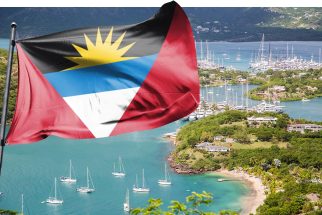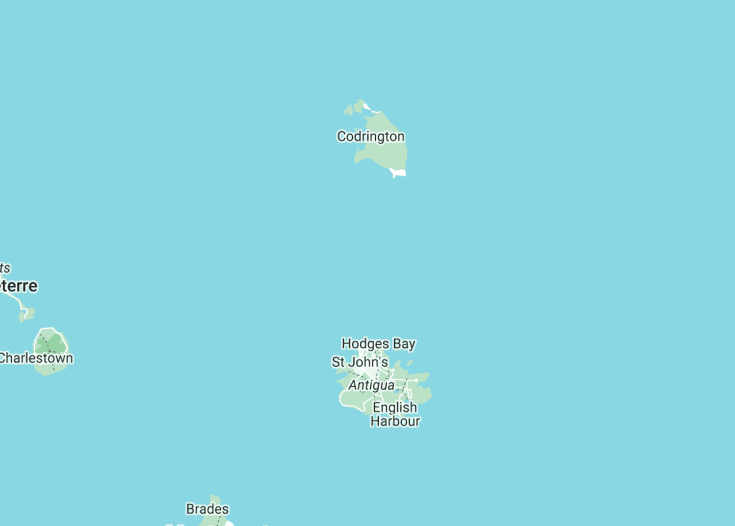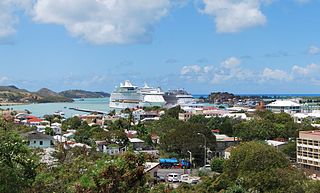Antigua and Barbuda, twin islands nestled in the heart of the Caribbean, epitomize tropical paradise. With 365 sun-kissed beaches, one for each day of the year, the islands allure with turquoise waters, powdery sands, and a rich colonial history. St. John’s, with its vibrant Saturday market and the historic Nelson’s Dockyard in English Harbour, narrates tales of a seafaring past. Lush rainforests, a kaleidoscope of marine life, and a fusion of Afro-Caribbean culture make Antigua and Barbuda an enchanting escape from the mundane.
For pristine snorkeling experiences, consider Cades Reef, where vivid corals and diverse marine life thrive.
Visitors should attend a local cricket match, an integral part of the islands’ culture and a vibrant social affair.
Top destinations in Antigua and Barbuda
Antigua and Barbuda: The Twin-Island Gem of the Caribbean
| Capital | St. John’s |
| Time in Antigua and Barbuda | GMT-4 |
| Language spoken | English |
| Population | 97,118 (World Bank, 2019) |
| Religion | Christian (Anglican) (73%) Other Christian Denominations (25%) Other Religions (2%) |
| Currency | East Caribbean Dollar (XCD) |
| Airports | V.C. Bird International Airport Sir George Walter Airport |
The twin-island nation of Antigua and Barbuda, shimmering like emerald jewels in the Caribbean Sea, possesses a magnetic allure that beckons travelers from afar. With a history deeply intertwined with the age of exploration, colonization, and the turbulent days of sugar plantations and piracy, these islands have borne witness to a mosaic of cultures and influences. Antigua, with its 365 beaches — one for each day of the year — and Barbuda, with its serene pink-hued sands and bird sanctuary, together present a tapestry of natural beauty and historical depth. The islands’ rich past, featuring indigenous peoples, European settlers, and African influences, has crafted a vibrant present-day culture of music, dance, and festivities.
Where is Antigua and Barbuda located?
Antigua and Barbuda is an island country located in the eastern Caribbean Sea. It is part of the Leeward Islands in the West Indies, lying between the Caribbean Sea and the Atlantic Ocean. The country is composed of two main islands: Antigua and Barbuda.
What is Antigua and Barbuda famous for?
Antigua and Barbuda is famous for its stunning white-sand beaches, crystal-clear turquoise waters, and colorful coral reefs. It is renowned for hosting the annual Antigua Sailing Week, a world-class sailing event that attracts sailors from around the globe. The country is also known for its rich history, with sites like Nelson’s Dockyard National Park showcasing its colonial past.
History
Early Inhabitants (2900 BC – 15th century AD)
Antigua and Barbuda’s earliest known settlers were the Siboney, or Stone Age people, who were followed by the Arawaks around 1200 BC. The Arawaks were agriculturists who made pottery and carved intricate zemi figures. However, by the turn of the 15th century, the Caribs, known for their seafaring skills, displaced the Arawaks after violent encounters, becoming the dominant group on the islands.
European Discovery and Colonization (1493-1834)
Christopher Columbus, during his second voyage in 1493, sighted Antigua and subsequently named it after the Church of Santa Maria de la Antigua in Seville. However, Spanish settlement attempts were thwarted by the Caribs’ resistance, the rough terrain, and lack of fresh water. It wasn’t until 1632 that English settlers successfully established a foothold on Antigua. The islands soon became an important colonial asset due to their strategic position and the success of sugar plantations. The establishment of these plantations necessitated a large workforce, leading to the massive importation of African slaves.
Path to Emancipation (1834-1860)
Over time, the growing discontent among enslaved Africans and changing attitudes towards slavery in Britain culminated in the Emancipation Act of 1834, which abolished slavery throughout the British Empire. While this marked the end of an egregious era, the newly-freed individuals faced numerous socio-economic challenges, including limited access to land and resources. This period saw a transition from outright slavery to a system of apprenticeship, wherein the formerly enslaved people were required to work for their former masters for a set number of years without wages.
Economic Shifts and Political Evolution (1860-1967)
The decline in the sugar industry in the late 19th century forced Antigua and Barbuda to diversify its economy. The establishment of a naval base by the British during World War II and the subsequent growth of the tourism sector in the post-war era slowly reshaped the islands’ economic landscape. Politically, the mid-20th century was marked by a burgeoning nationalist movement. The Antigua Labour Party, founded in 1946 under the leadership of V.C. Bird, played a significant role in the push for greater autonomy.
Independence and Modern Era (1967-Present)
Antigua became an associated state of the Commonwealth in 1967, granting it self-governance in internal affairs. On November 1, 1981, Antigua and Barbuda achieved full independence, with V.C. Bird becoming the nation’s first Prime Minister. Since then, the nation has steadily developed, focusing on tourism as its main economic driver. Politically, the nation has maintained stability, though it has faced challenges, including economic vulnerabilities and natural disasters. Today, Antigua and Barbuda, with its pristine beaches and rich cultural heritage, stands as a prominent destination in the Caribbean while actively participating in regional and global affairs.
Visit Antigua and Barbuda
What to see and do in Antigua and Barbuda
Antigua and Barbuda offer a diverse range of attractions and activities for visitors to enjoy. Here are some must-see and must-do experiences:
- Explore the historic Nelson’s Dockyard in English Harbour, a British naval dockyard dating back to the 18th century.
- Relax on the stunning beaches of Antigua, such as Dickenson Bay, Half Moon Bay, and Jolly Beach.
- Take a boat tour to the beautiful offshore islands of Barbuda and Redonda, known for their pristine beaches and wildlife.
- Visit Shirley Heights, a hilltop lookout with panoramic views of English Harbour and the surrounding islands.
- Experience the vibrant local culture through festivals, such as Antigua Carnival and the Caribana Festival.
- Go snorkeling or diving to explore the colorful coral reefs and marine life.
- Learn about the history and culture of Antigua and Barbuda at the Museum of Antigua and Barbuda in St. John’s.
Events in Antigua and Barbuda
Antigua and Barbuda is known for its lively events and festivals throughout the year. Some of the notable events include:
- Antigua Carnival (July/August) – A vibrant celebration of Caribbean culture with colorful costumes, music, and dancing.
- Sailing Week (April/May) – An internationally renowned sailing event that attracts participants from around the world.
- Antigua Charter Yacht Show (December) – A showcase of luxury yachts available for charter in the Caribbean.
- Barbuda Caribana (June) – A celebration of Barbuda’s indigenous Carib culture through music, dance, and art.
- Nelson’s Dockyard Christmas Party (December) – A festive event with live music, food stalls, and entertainment.
Best time to visit Antigua and Barbuda
The best time to visit Antigua and Barbuda is during the dry season, which runs from December to April. The weather is typically sunny and warm, making it ideal for outdoor activities and beach relaxation. However, this is also the peak tourist season, so expect higher hotel rates and crowds. If you prefer a quieter atmosphere and lower prices, consider visiting during the shoulder seasons of May to June or November. Avoid the hurricane season, which occurs from June to November, although the islands are equipped to handle any potential storms.
Is Antigua and Barbuda worth visiting?
Absolutely, Antigua and Barbuda are well worth visiting for their stunning beaches, rich history, and vibrant culture. The islands offer a wide range of activities and attractions for all types of travelers, whether you are seeking relaxation, adventure, or cultural immersion. The beautiful beaches alone make it worth a visit, with their powdery white sands and crystal-clear turquoise waters. Additionally, the historical sites, such as Nelson’s Dockyard and Shirley Heights, provide insight into the islands’ colonial past. The friendly locals and lively festivals add to the overall appeal of Antigua and Barbuda. However, it’s important to note that like any destination, it may not be to everyone’s taste. It is always recommended to research and plan your trip based on your own preferences and interests.
Common questions
What are the best beaches in Antigua and Barbuda?
- Dickenson Bay: This popular beach offers soft white sand, crystal-clear turquoise waters, and a range of water sports activities.
- Pigeon Point Beach: Located on the south coast, this secluded beach boasts calm waters and a peaceful atmosphere.
- Half Moon Bay: Surrounded by cliffs, Half Moon Bay is a beautiful crescent-shaped beach with powdery pink sand.
- Prickly Pear Island: Accessible only by boat, this uninhabited island features pristine beaches and great snorkeling opportunities.
- Darkwood Beach: Situated on the western coast, Darkwood Beach is known for its golden sand and calm, shallow waters.
What are the popular attractions in Antigua and Barbuda?
- Nelson’s Dockyard: This historic site is a beautifully restored Georgian naval dockyard and offers a glimpse into the island’s rich maritime history.
- Shirley Heights: Located in English Harbour, Shirley Heights is known for its breathtaking views of Antigua’s coastline and the neighboring islands.
- Natural Bridge: This natural rock formation is a must-see for nature lovers, offering stunning views of the coastline and surrounding scenery.
- Devil’s Bridge: A natural limestone arch formation, Devil’s Bridge is a geological wonder and a popular spot for sightseeing.
- Stingray City: Visitors can get up close and personal with stingrays in the calm, shallow waters of this attraction.
What is the best time to visit Antigua and Barbuda?
What activities are available in Antigua and Barbuda?
- Snorkeling and scuba diving: The islands are surrounded by beautiful coral reefs, making them ideal for underwater exploration.
- Sailing and boating: With numerous harbors and marinas, Antigua and Barbuda are perfect for sailing enthusiasts.
- Hiking and nature walks: Explore the islands’ lush landscapes and enjoy stunning views from mountaintop trails.
- Visit historical sites: Discover the rich history of the islands by visiting landmarks such as Nelson’s Dockyard and Betty’s Hope.
- Relax on the beaches: Antigua and Barbuda are home to many pristine beaches where visitors can unwind and soak up the sun.
What are the local dishes to try in Antigua and Barbuda?
- Antiguan Black Pineapple: This sweet and juicy pineapple is a local specialty and is often used in desserts and cocktails.
- Pepperpot: A rich and flavorful meat stew made with a variety of spices, vegetables, and meats.
- Fungee and Pepperpot: Fungee is a cornmeal-based dish similar to polenta, served with the flavorful Pepperpot stew.
- Ducana: A sweet potato dumpling flavored with spices such as cinnamon and nutmeg, often served with saltfish.
- Conch Fritters: Made with conch meat, these deep-fried fritters are a popular appetizer or snack.
What are the options for accommodation in Antigua and Barbuda?
- Luxury resorts: There are several high-end resorts on the islands that offer luxury accommodations, gourmet dining, and world-class amenities.
- All-inclusive resorts: Many resorts in Antigua and Barbuda offer all-inclusive packages, which include accommodations, meals, drinks, and sometimes activities.
- Boutique hotels: For a more intimate and personalized experience, boutique hotels are a great option. These smaller hotels often offer unique décor and personalized service.
- Vacation rentals: Visitors can also rent private villas, apartments, or cottages for a more independent and home-like experience.
- Guesthouses and B&Bs: There are several guesthouses and bed and breakfast establishments on the islands, offering cozy accommodations and a chance to interact with locals.
What are the transport options in Antigua and Barbuda?
- Taxis: Taxis are readily available on the islands and can be hired for individual trips or for a full day.
- Rental cars: Renting a car is a popular choice for those who want to explore the islands at their own pace. Several rental companies operate on the islands.
- Public buses: Antigua and Barbuda have a public bus system that provides affordable transportation between major towns and attractions.
- Bicycle rentals: Bicycles can be rented in some areas, offering a fun and environmentally friendly way to explore the islands.
- Boat tours: For a unique perspective, visitors can also take boat tours to explore the coastline and surrounding islands.
What is the nightlife like in Antigua and Barbuda?
- Beach bars and restaurants: Many beachfront establishments offer live music, DJ performances, and a lively atmosphere.
- Clubs and discos: There are several clubs and discos where visitors can dance the night away to local and international music.
- Casinos: Antigua has a number of casinos where visitors can try their luck at various games.
- Night markets and events: Occasionally, night markets and cultural events are held, offering a chance to sample local cuisine, purchase crafts, and enjoy live entertainment.
What are some popular souvenirs to buy in Antigua and Barbuda?
- Antiguan Rum: The islands are known for their rum production, and visitors can purchase a bottle as a souvenir.
- Handcrafted items: Look for locally made crafts such as pottery, jewelry, paintings, and textiles.
- Local spices: Antigua and Barbuda are known for their flavorful spices, and spice blends make great souvenirs.
- Antiguan black pineapple products: From jams and preserves to delicious desserts, products made with Antiguan black pineapple are a tasty and unique souvenir.
- Antiguan coffee: Coffee lovers can bring home locally roasted beans or ground coffee for an authentic taste of the islands.
Are there any natural attractions to visit in Antigua and Barbuda?
- Devil’s Bridge: This natural rock arch formation is a scenic and unique attraction.
- Natural Bridge: As the name suggests, this natural rock formation resembles a bridge and offers beautiful views of the coast.
- Great Bird Island: A nature reserve, this island is home to a variety of bird species and offers scenic hiking trails.
- Indian Town National Park: This park showcases the rugged coastline and offers scenic hiking trails and beautiful viewpoints.
- The Pillars of Hercules: These towering limestone pillars are a spectacular sight and offer panoramic views of the ocean.
What water activities can be enjoyed in Antigua and Barbuda?
- Snorkeling and scuba diving: The islands are surrounded by coral reefs, providing excellent opportunities for underwater exploration.
- Sailing and boating: With their many harbors and marinas, the islands are a paradise for sailing enthusiasts.
- Kayaking and paddleboarding: Calm waters and beautiful coastlines make Antigua and Barbuda perfect for kayaking and paddleboarding.
- Fishing: Visitors can enjoy deep-sea fishing or try their hand at fly-fishing in the islands’ bountiful waters.
- Jet skiing and water skiing: Thrill-seekers can enjoy jet skiing or water skiing in the clear blue waters of Antigua and Barbuda.











